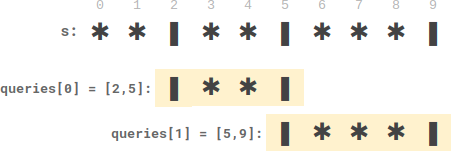Plates Between Candles
There is a long table with a line of plates and candles arranged on top of it. You are given a 0-indexed string s consisting of characters '*' and '|' only, where a '*' represents a plate and a '|' represents a candle.
You are also given a 0-indexed 2D integer array queries where queries[i] = [lefti, righti] denotes the substring s[lefti...righti] (inclusive). For each query, you need to find the number of plates between candles that are in the substring. A plate is considered between candles if there is at least one candle to its left and at least one candle to its right in the substring.
- For example,
s = "||**||**|*", and a query[3, 8]denotes the substring"*||**|". The number of plates between candles in this substring is2(at indices6and7), as each of the two plates has at least one candle in the substring to its left and right.
Return an integer array answer where answer[i] is the answer to the ith query.
Example 1:

Input: s = "**|**|***|", queries = [[2,5],[5,9]]
Output: [2,3]
Explanation:
- queries[0] has two plates between candles.
- queries[1] has three plates between candles.
Example 2:

Input: s = "***|**|*****|**||**|*", queries = [[1,17],[4,5],[14,17],[5,11],[15,16]]
Output: [9,0,0,0,0]
Explanation:
- queries[0] has nine plates between candles.
- The other queries have zero plates between candles.
Constraints:
3 <= s.length <= 105sconsists of'*'and'|'characters.1 <= queries.length <= 105queries[i].length == 20 <= lefti <= righti < s.length
Solution
To find the number of plates for each query (qleft, qright), we set up an array candles to store the candles' indices, so that we could later do basic arithmetic on the indices to find the number of plates.
First, we need to find the outside candles' indices in the input s, this can be done via binary search in candles. We will find left_pos and right_pos indicating the outside candle's position in s.
Then, We know that the number of plates is given by the interval between the two bounding candles subtracted by the number of candles in between.
With the indices left_pos and right_pos, we can derive the number of plates to be (candles[right_pos] - candles[left_pos]) - (right_pos - left_pos).
Implementation
1def platesBetweenCandles(s, queries):
2 candles = []
3 for i in range(len(s)):
4 if s[i] == '|': candles.append(i)
5
6 res = []
7 for qleft, qright in queries:
8 left_pos, right_pos = -1, -1
9
10 # 1. find index of first candle that comes after qleft
11 left, right = 0, len(candles)-1
12 while left <= right:
13 mid = (left+right) // 2
14 if candles[mid] >= qleft:
15 right = mid - 1
16 left_pos = mid
17 else:
18 left = mid + 1
19
20 # 2. find index of last candle that comes before qright
21 left, right = 0, len(candles)-1
22 while left <= right:
23 mid = (left+right) // 2
24 if candles[mid] <= qright:
25 left = mid + 1
26 right_pos = mid
27 else:
28 right = mid - 1
29
30 # result = range between two outermost candles - candle count in between
31 if (left_pos != -1) & (right_pos!= -1) & (right_pos > left_pos):
32 res.append((candles[right_pos] - candles[left_pos]) - (right_pos - left_pos))
33 else:
34 res.append(0)
35 return res
Suppose k is a very large integer(2^64). Which of the following is the largest as n grows to infinity?
Problem: Given a list of tasks and a list of requirements, compute a sequence of tasks that can be performed, such that we complete every task once while satisfying all the requirements.
Which of the following method should we use to solve this problem?
Solution Implementation
Consider the classic dynamic programming of fibonacci numbers, what is the recurrence relation?
Which technique can we use to find the middle of a linked list?
Recommended Readings
Top Patterns to Conquer the Technical Coding Interview Should the written word bore you fear not A delightful video alternative awaits iframe width 560 height 315 src https www youtube com embed LW8Io6IPYHw title YouTube video player frameborder 0 allow accelerometer autoplay clipboard write encrypted media gyroscope picture in picture
Recursion Recursion is one of the most important concepts in computer science Simply speaking recursion is the process of a function calling itself Using a real life analogy imagine a scenario where you invite your friends to lunch https algomonster s3 us east 2 amazonaws com recursion jpg You first
Runtime Overview When learning about algorithms and data structures you'll frequently encounter the term time complexity This concept is fundamental in computer science and offers insights into how long an algorithm takes to complete given a certain input size What is Time Complexity Time complexity represents the amount of time
Got a question? Ask the Teaching Assistant anything you don't understand.
Still not clear? Ask in the Forum, Discord or Submit the part you don't understand to our editors.